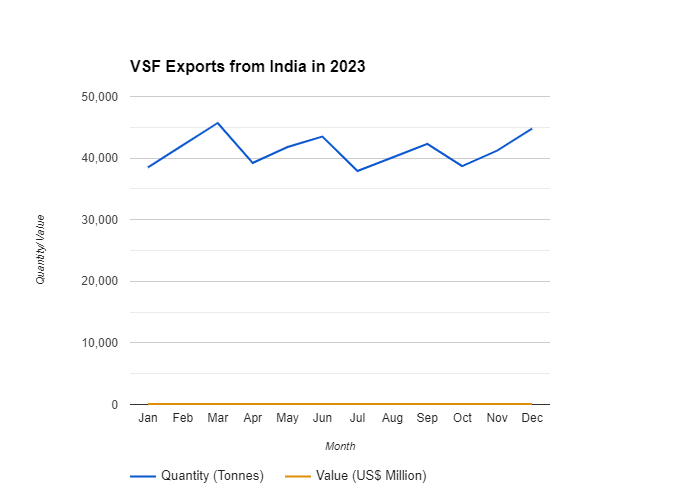VSF Boom Across Asia: India rides the wave of increased Rayon yarn demand in January
Defying seasonal sluggishness, the Asian textile industry is experiencing vibrant growth in demand for Viscose Staple Fiber (VSF), a key material in rayon yarn production. This demand boost, observed throughout January, paints positive picture for the sector despite global economic uncertainties.
Unseasonal buzz: Traditionally, January, with the Spring festival looming, Asia sees a dip in textile activity. However, this year, VSF and rayon yarn manufacturers are grappling with abundant orders, prompting them to shorten holiday breaks and ramp up production. This proactive response is being attributed to numerous factors: strong post-pandemic recovery, efficient production processes, and reduced inventory levels.
Echoes of August: This isn't the first time the VSF market has defied seasonal patterns. In August 2023, rayon yarn mills maintained a commendable 90 per cent capacity utilization rate, further underlining the sector's agility and responsiveness.
Post-festival outlook: While downstream industries are expected to take their customary February break, the duration is likely to be shorter than usual. This, coupled with historically strong demand between February and April, adds to the optimistic outlook. Additionally, easier access to loans at the beginning of the year bolsters optimism within the industry.
Other factors: The growing popularity of comfortable, sustainable clothing made with natural fibers like viscose is driving demand. VSF's breathability and drape make it ideal for casual wear, particularly in warmer weather approaching with spring. Also, ongoing trade tensions and concerns about global economic slowdown are leading some buyers to diversify their sourcing, potentially boosting demand for Asian VSF producers. Moreover, in anticipation of a strong post-holiday demand, coupled with concerns about potential supply disruptions later in the year, many manufacturers are restocking VSF inventories early
Global headwinds: Despite the buoyancy, acknowledging global economic uncertainties is crucial. The World Bank and IMF predict a challenging 2024, with sluggish global demand potentially impacting export-oriented textile players.
India's Market: Indian VSF sector, a significant player in the Asian market, mirrors the regional trends. Leading producers like Birla Cellulose and Grasim Industries are reporting robust demand and low inventory levels. However, India's dependence on imported wood pulp, a key VSF feedstock, could pose supply chain challenges amid global economic turbulence.
VSF exports from India in 2023
|
Statistic |
Data |
Source |
|
Total VSF Exports (FY 2023-24) |
580,000 MT (estimated) |
Indian Rayon Producers Association (IRPA) |
|
Year-on-Year Growth (YOY) |
+12% |
IRPA |
|
Top Export Destinations (2023) |
Bangladesh (20%) |
The Textile Exchange |
|
Average Export Price (2023) |
USD 850-900 per MT |
ChemAnalyst |
|
Key Growth Drivers: |
Strong global demand for textiles |
The Textile Exchange |
|
Challenges |
Dependence on imported wood pulp |
IRPA |
Global market outlook 2024
ChemAnalyst, a leading market research firm, predicts positive trend in VSF prices for February due to anticipated post-holiday demand. However, a potential supply-demand imbalance could further push prices up. Some caution is warranted. The long-term impact of factors like inflation, rising energy costs, and potential policy changes remains to be seen. Additionally, the sustainability of VSF production, particularly its environmental footprint, needs to be continuously addressed to ensure long-term growth. Navigating this dynamic landscape will require manufacturers to adopt a cautious and adaptable approach, balancing domestic opportunities with global uncertainties.
The Asian textile industry, particularly the VSF segment, is experiencing a remarkable upswing, defying seasonal norms and economic worries. However, staying grounded and vigilant in the face of global headwinds will be crucial to safeguard this hard-won momentum in 2024.

